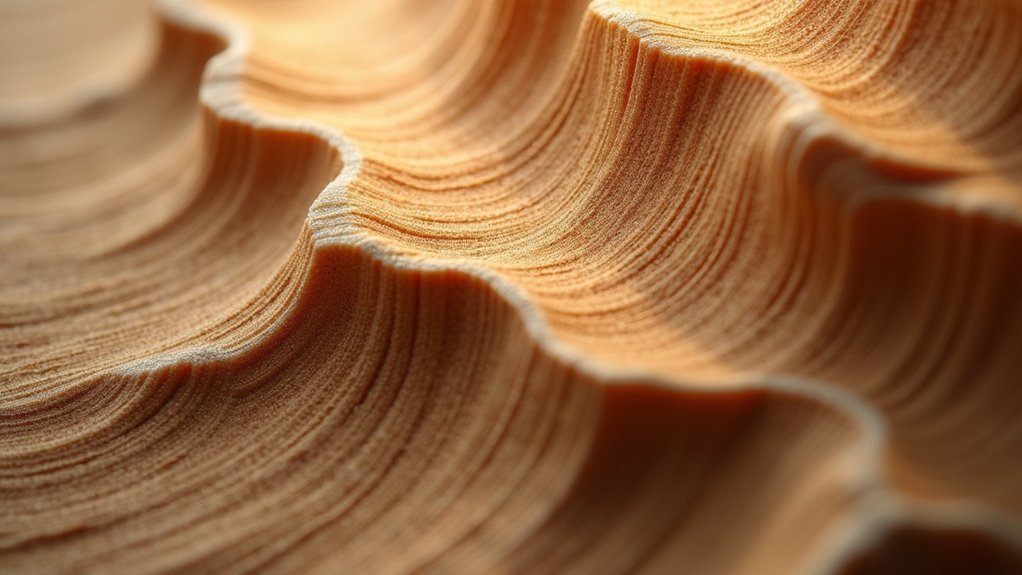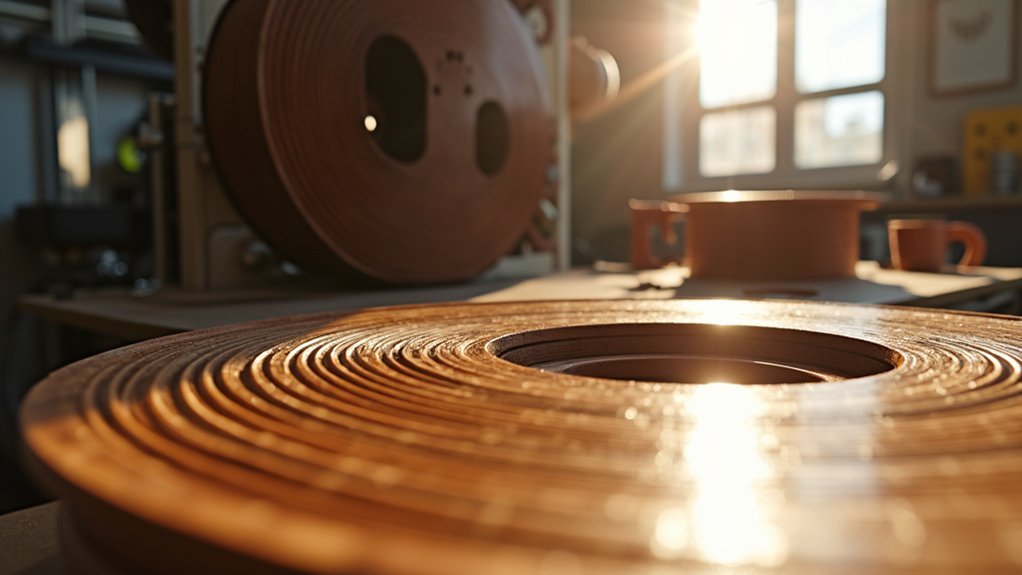Wood-filled filaments combine approximately 30% recycled wood fibers with 70% PLA, creating material that mimics real timber’s appearance and woody scent. You’ll notice reduced tensile strength compared to standard PLA but increased stiffness, making prints more brittle with decreased flexibility. These filaments require hardened steel nozzles and specific temperature settings between 180°C-200°C for ideal results. They offer sustainable printing alternatives while presenting unique processing challenges that affect your printing approach and final product characteristics.
Composition and Base Materials of Wood-Filled Filaments

Wood-filled filaments represent a fascinating blend of natural and synthetic materials, typically combining around 30% wood fibers with 70% PLA (polylactic acid) as the base polymer.
You’ll find these wood fibers come from recycled wood or wood by-products, making them an environmentally conscious choice for your 3D printing projects.
When you’re selecting wood-filled filaments, you’ll encounter various compositions. Some manufacturers enhance their blends with additional materials like PHA to improve durability and performance.
The wood sources can vary considerably, from spruce fibers in Timberfill to custom blends that manufacturers create for specific applications.
Different wood sources offer unique characteristics, from spruce-based Timberfill to specialized manufacturer blends designed for targeted printing applications.
You’re fundamentally working with a sustainable material that reduces environmental impact while maintaining the workability of traditional PLA, giving you the best of both worlds. During printing, these filaments emit a distinctive woodshop smell that adds to the authentic wood-working experience.
Physical and Mechanical Properties Analysis
Understanding the composition gives you the foundation, but the real performance of wood-filled filaments depends on their physical and mechanical characteristics.
You’ll find that adding wood fibers decreases tensile strength—20% beech wood-filled PLA drops to 49 MPa compared to pure PLA. However, you’ll gain stiffness, with Young’s modulus increasing to 3.94 GPa.
The trade-off comes in flexibility, as strain at break decreases from 6.3% to 2.1% with higher wood content.
Wood particles create 50 µm voids during printing, affecting material continuity.
You’ll notice density varies based on wood content and type, influencing your print’s weight.
Thermal conductivity remains similar to PLA at 100-200 mW/mK, though porosity can impact heat transfer between layers. Wood-filled composites also demonstrate increased stiffness compared to pure PLA materials.
Surface Texture and Aesthetic Characteristics

You’ll immediately notice wood-filled filament’s distinctive visual appeal that closely mimics real timber’s natural grain patterns and color variations.
The printed surface offers remarkable texture variety, ranging from smooth pine-like finishes to rough walnut appearances depending on your print settings and particle composition.
When you handle fresh prints, you’ll experience an authentic woody scent and tactile feel that standard plastic filaments simply can’t replicate.
These filaments typically contain around 30% wood particles mixed with PLA base material, creating the authentic wooden characteristics you observe in finished prints.
Natural Wood-Like Appearance
When you examine a wood-filled filament print up close, you’ll immediately notice how it mimics real wood grain patterns and natural color variations that set it apart from typical plastic materials. The surface exhibits authentic shading and wood-like mottling that emerges visibly, especially with larger nozzles and higher layer heights.
| Wood Type | Color Range | Grain Characteristics |
|---|---|---|
| Oak | Light tan to medium brown | Prominent, bold patterns |
| Mahogany | Rich reddish-brown | Fine, elegant graining |
| Pine | Pale yellow to amber | Subtle, linear streaks |
| Walnut | Dark chocolate brown | Dense, swirled textures |
Each print you create is unique due to batch variability in wood fiber distribution. You’ll find the grain structure becomes more pronounced when you adjust printing parameters, giving your objects an authentically natural appearance that blends seamlessly with real wooden surroundings. The material provides a natural aesthetic that makes decorative objects particularly appealing for display purposes.
Texture and Finish Variety
The tactile experience of wood-filled filament prints transforms ordinary 3D objects into remarkably authentic wooden replicas that feel genuine under your fingertips.
Wood particles embedded within the filament create natural grain patterns and rougher surfaces compared to smooth PLA, delivering an organically variable texture that mimics real wood’s appearance and feel.
You’ll find finish variability depends on several factors: the type and amount of wood particles used, your print settings like temperature and speed, and the specific wood derivatives incorporated.
Some filaments produce pronounced textures while others appear smoother. The less abrasive nature makes printing relatively easy, though you’ll need slightly larger nozzles to prevent clogs.
Post-processing techniques can further enhance your prints’ natural wooden finish. Beyond visual appeal, wood-filled prints emit a distinctive wood aroma during and after printing, adding another layer of authenticity to the experience.
Authentic Scent Properties
Beyond texture alone, wood-filled filaments engage multiple senses by releasing an authentic woody aroma that transforms your printing space into something reminiscent of a woodworking shop.
The real wood dust or cork particles mixed with PLA base create this distinctive scent during printing, enhancing your experience beyond visual appeal.
You’ll notice these aromatic characteristics:
- Mild, pleasant fragrance that won’t overpower your workspace, making it suitable for indoor printing
- Natural wood scent that varies in intensity depending on the wood particle type and brand you choose
- Gradual fade after printing, though residual woody fragrance temporarily remains on finished parts
- Enhanced sensory experience that complements the visual and tactile wood-like properties of your prints
Timberfill’s composition includes natural fibers from spruce, which contributes to its distinctive aromatic profile and authentic wood-like characteristics.
Printability Requirements and Performance Factors

Successfully printing with wood-filled filaments requires careful attention to several critical hardware and software adjustments that differ markedly from standard PLA printing parameters.
You’ll need a hardened steel or ruby nozzle with 0.4mm to 0.8mm diameter, as wood particles accelerate wear and can clog smaller openings. Set your extruder temperature between 180°C-200°C and print speeds at 20-45mm/s for consistent flow.
Use layer heights of at least 0.2mm to accommodate wood fibers and prevent clogs. Configure retraction around 5mm to minimize stringing.
While heated beds aren’t essential, 40°C-60°C improves adhesion for larger prints. Wood-filled filaments exhibit strong adhesion to smooth PEI surfaces, so consider using a separation layer or satin sheet to prevent damage during print removal. Run cooling fans at 50-100% for best surface finish and reduced stringing on complex geometries.
Environmental Impact and Sustainability Benefits
While conventional 3D printing filaments contribute to mounting plastic waste concerns, wood-filled alternatives offer compelling environmental advantages that align with sustainable manufacturing goals.
You’ll find these filaments combine renewable wood fibers with biodegradable base materials like PLA, creating products that break down naturally rather than persisting in landfills for decades.
The sustainability benefits you’ll experience include:
- Renewable sourcing – Wood waste and fibers from sustainable forestry reduce dependence on petroleum-based plastics
- Home composting – Certain formulations decompose in backyard compost bins without industrial facilities
- Lower carbon footprint – Manufacturing requires less energy than traditional plastic production
- Waste reduction – Repurposing wood waste prevents disposal issues while supporting circular economy principles
You’re choosing materials with non-toxic ingredients that maintain food safety while delivering the natural aesthetics of real wood. These innovative filaments incorporate sawdust and waste from furniture manufacturing, transforming what would otherwise be discarded materials into valuable 3D printing resources.
Processing Limitations and Technical Challenges
Despite their environmental advantages, wood-filled filaments present significant processing challenges that you’ll need to navigate carefully to achieve successful prints.
You’ll encounter frequent nozzle clogging with standard 0.35-0.4mm nozzles due to wood particle clumping, requiring larger 0.5mm+ nozzles and hardened steel construction to handle abrasive content.
Temperature control becomes critical—you’ll need slightly elevated temperatures for layer adhesion while avoiding wood fiber degradation.
Reduced print speeds are essential to prevent defects, and retraction settings require fine-tuning since wood fibers interfere with normal suction pressure, causing oozing and stringing.
The filaments’ brittleness makes them unsuitable for load-bearing applications, and moisture absorption can cause steaming and blockages, necessitating proper filament drying. Regular maintenance needs become paramount to monitor nozzle wear and prevent gradual performance degradation throughout extended printing sessions.
Frequently Asked Questions
How Much Does Wood-Filled Filament Cost Compared to Standard PLA?
You’ll pay $40-60 per kilogram for wood-filled filament, while standard PLA costs $15-30 per kilogram. Wood-filled filaments are specialty materials, making them roughly twice as expensive as regular PLA.
Can Wood-Filled Prints Be Stained or Painted Like Real Wood?
You can stain and paint wood-filled prints just like real wood. The natural wood fibers accept stains beautifully, and you’ll get better results if you sand the surface first.
What Is the Shelf Life of Unopened Wood-Filled Filament Spools?
You’ll get up to 24 months of shelf life from unopened wood-filled filament spools when they’re stored properly at room temperature with humidity below 15% in their original airtight packaging.
Are Wood-Filled Filaments Compatible With All 3D Printer Brands?
You’ll find wood-filled filaments work with most FDM 3D printer brands since they’re generally compatible across different manufacturers. However, you’ll need a 0.4mm or larger nozzle for best results.
How Do You Sand and Finish Wood-Filled Prints for Smoothness?
Start with 120-150 grit sandpaper, then progress to finer grits like 220-400. Use sanding blocks for even pressure. Apply wood stains, then seal with polyurethane or natural oils for protection.
In Summary
You’ll find wood-filled filaments offer a unique blend of plastic flexibility and natural wood aesthetics. They’re easier to print than pure plastics while delivering authentic wood grain textures and the ability to sand, stain, or paint post-processing. You’ll appreciate their eco-friendly composition and lower environmental impact. However, you’ll need to manage challenges like nozzle wear, temperature sensitivity, and potential warping during printing.





Leave a Reply